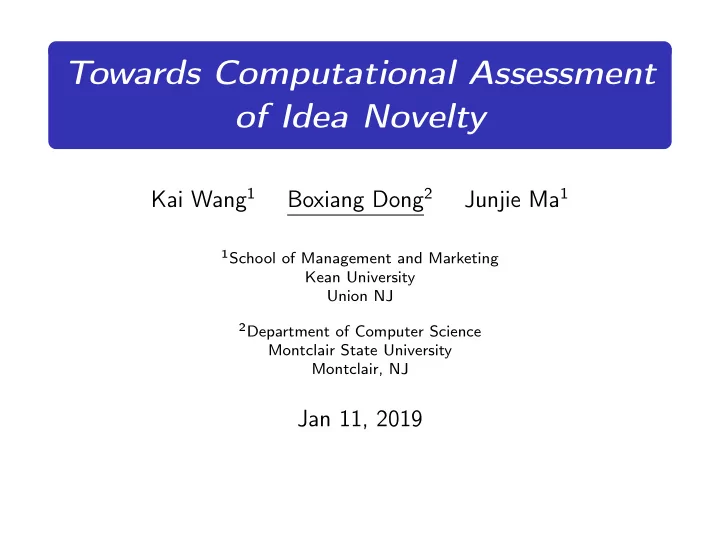

Towards Computational Assessment of Idea Novelty Kai Wang 1 Boxiang Dong 2 Junjie Ma 1 1 School of Management and Marketing Kean University Union NJ 2 Department of Computer Science Montclair State University Montclair, NJ Jan 11, 2019
Idea Collection • Companies collect ideas from a large number of people to improve existing offerings [AT12, WN17]. 2 / 19
Idea Novelty Assessment • Manually selecting the most innovative ideas from a large pool is not effective. 3 / 19
Idea Novelty Assessment • Manually selecting the most innovative ideas from a large pool is not effective. • It would be very helpful to automate the evaluation of creative ideas. 4 / 19
Idea Novelty Assessment Latent Semantic Analysis (LSA) Idea Similarity Comparison Latent Dirichlet Allocation (LDA) Proposal Novelty Evaluation Term Frequency-Inverse Document Frequency (TF-IDF) However, none of these approaches have been validated through the comparison with human judgment. 5 / 19
Our Contribution • Three computational idea novelty evaluation approaches • LSA • LDA • TF-IDF • Three sets of ideas • Comparison with human expert evaluation 6 / 19
Outline 1 Introduction 2 Background 3 Methods 4 Results 5 Conclusion 7 / 19
Background - LSA [CS15, TN16] Input Idea by word matrix Output Idea by topic matrix Key Idea Apply Singular Value Decomposition (SVD) on the input matrix. K S T = D T x x Word by Topic by Word by Idea Idea by Topic Topic Topic Matrix Matrix Matrix Matrix (m * n) (n * z) (m * z) (z * z) 8 / 19
Background - LDA [WNS13, Has17] Input Idea by word matrix Output Idea by topic matrix • Each idea is represented as a mixture of Key Idea latent topics. • Each topic is characterized as a distribution over words. = P(t|d) P(w|d) P(w|t) x Idea Idea Distribution Topic Distribution over Distribution over Words Words over Topics (m * n) (n * k) (k * m) 9 / 19
Background - TF-IDF [WB13] Input Idea by word matrix Output Idea by word tf-idfs Key Idea Determine how important a word is to an idea. n tf - id f ( w i , d j ) = tf ( w i , d j ) × log( f ( w i )) d tf ( w i , d j ): # of times that w i appears in d j f ( w i ): # of ideas that include w i d n : # of id eas 10 / 19
Methods - Data Collection We use Amazon Mechanical Turk (www.mturk.com) to employ crowd workers to collect three set of ideas. Alarm Ideas about a mobile app of an alarm clock. Fitness Ideas to improve physical fitness. Advertising Ideas to promote TV advertising. Dataset # of Ideas Avg. # of Characters Alarm 200 555 Fitness 240 586 Advertising 300 307 11 / 19
Methods - Human Expert Evaluation We hire a group of human experts to evaluate the collected ideas. • Each idea is evaluated by at least two human experts. • Novelty is defined by using a Likert scale of 1 to 7 (1 being not novel at all, 7 being highly novel). • Human experts demonstrate reasonable level of agreement in the ratings (Intraclass correlation coefficient is higher than 0.7). • We take the average of human ratings as the ground truth of idea novelty. 12 / 19
Methods - Computational Novelty Evaluation LSA Cosine distance to average LDA • Use Gibbs sampling with 2,000 iterations • Cosine distance to average TF-IDF Sum of all tf-idfs in an idea 13 / 19
Experiments We compare the following methods with the ground truth. LSA LDA TF-IDF Crowd We hire 20 crowd workers to manually evaluate the idea novelty, and take their average. 14 / 19
Experiments • LSA correlates well with the ground truth on the Fitness and TV Advertising datasets. • LDA and TF-IDF performs well on all three datasets. • Crowd evaluation correlates with expert evaluation better than all the three computational methods. 15 / 19
Experiments • Crowd evaluation identifies more top-10 novel ideas than all computational approaches. • Crowd evaluation resulted in significant point-biserial correlation for all three ideation tasks 16 / 19
Conclusion We experimentally compare three computational novelty evaluation approaches with ground truth. • TF-IDF outperforms LSA and LDA in matching expert evaluation. • All three computational approaches fall far behind crowd evaluation. • Much more research is needed to automate the evaluation of creative ideas. 17 / 19
References I [AT12] Allan Afuah and Christopher L Tucci. Crowdsourcing as a solution to distant search. Academy of Management Review , 37(3):355–375, 2012. [CS15] Joel Chan and Christian D Schunn. The importance of iteration in creative conceptual combination. Cognition , 145:104–115, 2015. [Has17] Richard W Hass. Tracking the dynamics of divergent thinking via semantic distance: Analytic methods and theoretical implications. Memory & cognition , 45(2):233–244, 2017. [TN16] Olivier Toubia and Oded Netzer. Idea generation, creativity, and prototypicality. Marketing science , 36(1):1–20, 2016. [WB13] Thomas P Walter and Andrea Back. A text mining approach to evaluate submissions to crowdsourcing contests. In System Sciences (HICSS), 2013 46th Hawaii International Conference on , pages 3109–3118. IEEE, 2013. [WN17] Kai Wang and Jeffrey V Nickerson. A literature review on individual creativity support systems. Computers in Human Behavior , 74:139–151, 2017. [WNS13] Kai Wang, Jeffrey V Nickerson, and Yasuaki Sakamoto. Crowdsourced idea generation: the effect of exposure to an original idea. 2013. 18 / 19
Q & A Thank you! Questions?
Recommend
More recommend